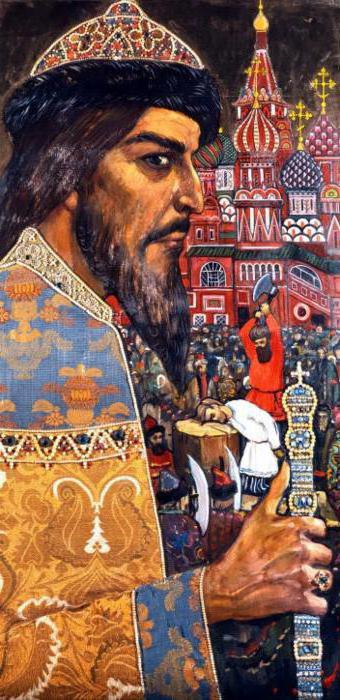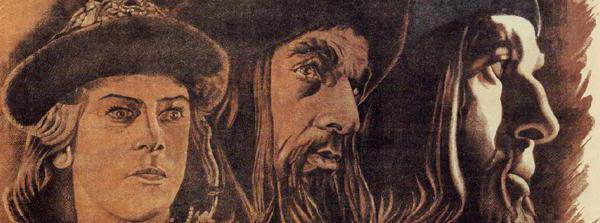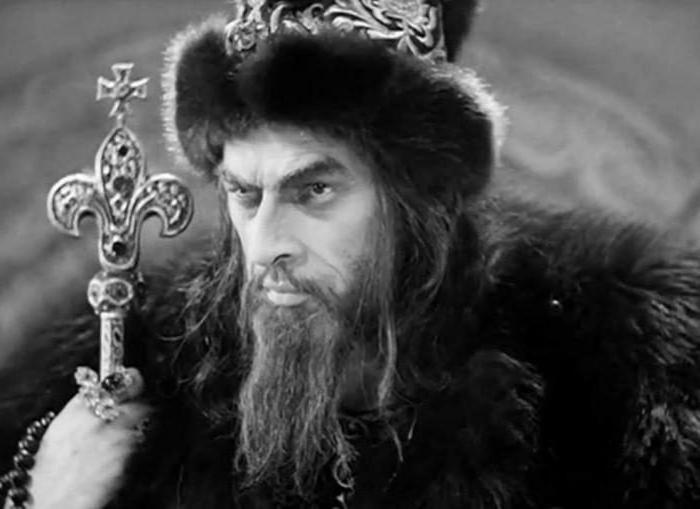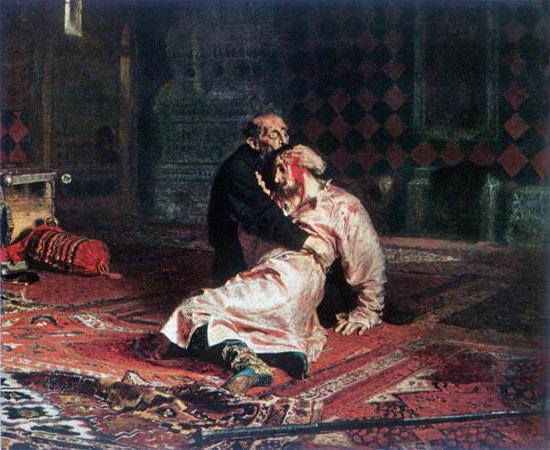Ivan Vasilievich, the penultimate of the Rurikovich dynasty and the first king of his kind, was an outstanding person. In it, surprisingly coexisted, the opposite of human nature traits of character. The early deaths of father and mother, the chaos of the boyar clans in the struggle for power and other important reasons left their indelible imprint on the formation of the person of the future Tsar Ivan IV, later nicknamed the Terrible.
Birth of an heir
The whole twenty years of the married life of Vasily III with Solomonia Saburova were in vain. Many years of marriage did not lead to the birth of the coveted heir to the throne. In this situation, power would have passed either to Yuri Ivanovich Dmitrovsky, or to Andrei Ivanovich Staritsky - the brothers of the Grand Duke. Whom Vasily III addressed to: doctors, healers, healers ... Everything is in vain. Then the Grand Duke decided to heed the advice of Metropolitan Daniel, who recommended divorcing Solomonia Saburova. The current situation required this. A twenty-year marriage was dissolved in the fall of 1525, and the ex-wife was tonsured by force and sent to the monastery. The new companion of the Grand Duke’s life was Elena Glinskaya, niece of Prince Mikhail Glinsky, a native of Lithuania. The wedding took place in January 1526. The choice of a new wife was not accidental. Having listened to the advice of Metropolitan Daniel, Vasily III longed not only for the heir. In the future, the Grand Duke could lay claim to the Lithuanian throne, as well as establish relations with the West European powers. The desired son had to wait another 4 years. In August 1530, the long-awaited boy was born, who was given the name Ivan. By that time, Vasily III was 51 years old. A couple of years later a second son was born, Yuri. Unfortunately, the joy of his father lasted 3 years. In December 1533, the Grand Duke passed away.
Childhood and Regency
The grand-ducal title passed to 3-year-old Ivan Vasilievich. Naturally, he could not rule on his own. Nominally, power came to Elena Glinsky, and the country was officially led by her uncle Mikhail. But the latter was then deposed (died of starvation in prison), favorite of Princess Ivan Fyodorovich Ovchina-Telepnev-Obolensky. First of all, the mother of the young grand duke decided to rid his son of competitors, who were his own uncles, brothers Basil III. Yuri Ivanovich Dmitrovsky was sent to prison in December 1533, where he soon died. Andrei Ivanovich Staritsky in 1537 organized a riot, which was suppressed, and its organizer was arrested, and soon died of starvation in prison. Having got rid of the main contenders for power, Elena Glinskaya and her supporters set about reforming activities. Cities and fortresses were rebuilt. In 1538, a monetary reform was carried out that actually led the country to a single monetary system. This transformation had many opponents among the boyar stratum. In 1538, Princess Elena Glinskaya passed away. Some sources claim that she was poisoned by Shuiskys. Soon her favorite Ivan Ovchina-Telepnev-Obolensky was captured and imprisoned (he died of starvation). Other opponents of the coup were also eliminated. A fierce battle began between the Shuysky, Belsky and Glinsky for the right to guardianship. And the young grand duke for many years witnessed lawlessness, intrigue, humiliation, violence and lies. All this was deeply imprinted in memory of an inquisitive orphan and his younger brother. The Shuysky were especially distinguished, who after the death of Elena Glinsky actually usurped power and did not deny themselves any pleasures, wasting the state treasury and taxing people with exorbitant taxes. The growing Grand Duke was more and more imbued with hatred for the boyar stratum. However, it was then that cruelty first appeared in him. At the age of 13, Ivan Vasilievich decided to indicate to their arrogant guardians their place. The Grand Duke ordered the kennel to kill the oldest of the Shuiskys - Andrei. After this incident, some boyars became afraid of the rising ruler. However, his uncle Glinsky took advantage of the situation. They began to get rid of competitors by reference.

The first king of all Russia
Watching all the arbitrariness that was happening before his eyes, the growing Grand Duke became increasingly convinced that an unlimited absolute monarchy was an ideal form of government in the fight against boyar lawlessness. One of the supporters of this idea was Metropolitan Macarius. It was to him that the young prince turned with a double request. At 16, he felt independent enough for the sole leadership of the country and asked the Metropolitan to crown him king. In addition, Ivan Vasilievich also intended to get married as soon as possible. On January 16, 1547, an official wedding ceremony for the kingdom took place in the Assumption Cathedral. The Grand Duke became the first king of the Rurik family. In addition, by title, he now stood on a par with other European monarchs. On February 3, Ivan Vasilievich married Anastasia Romanova Zakharyina-Yurieva. This woman was able to bring harmony to her husband’s life, significantly curbing his violent temper. None of the following wives had as much influence on the king as his first life partner. The beginning of the reign of Ivan the Terrible (well, not yet quite Grozny) would have been ideal, if not the events that had happened already in the summer of that year.

The first trials for the king
The beginning of the reign of Ivan the Terrible, in short, turned out to be blurry by the summer of 1547. On June 21, a fire broke out in Moscow on an unprecedented scale, lasting about 10 hours and covering most of the city. Most of the buildings burned down, and a lot of people died. But the disaster did not end there. The furious people accused the Glinsky, close relatives of the tsar of all calamities. June 26, residents of Moscow began an open speech. Uncle of the Tsar Yuri Glinsky became a victim of a mad crowd. The rest of Glinsky hastily left the city. On June 29, the rebels went to the village of Vorobyevo in the Moscow region, where the sovereign was, intending to find out from him the whereabouts of his relatives. It took a lot of effort for the newly-made monarch to persuade people to calm down and disperse. After the last spark of the uprising went out, the young king ordered the organizers of the speech to be found and executed. Thus, the year 1547, the year the reign of Ivan the Terrible began, further convinced the young tsar of the need for reform.
Chosen Council
Reforms of the Chosen Rada and the beginning of the reign of Ivan the Terrible started in one time period for a reason. The young king was far from the only person who believed that the country needed transformation. One of his first supporters was Metropolitan Macarius. By 1549, the imperial confessor Sylvester, the notorious nobleman A. Adashev, clerk I. Viskovaty, clerk I. Peresvetov, princes D. I. Kurlyatev, A. M. Kurbsky, N. I. Odoevsky, M I. Vorotynsky and other lesser-known personalities. Later, the prince called this circle the Elected Rada, which was a non-governmental consultative and executive body.
Domestic Politics and Reforms
The main reason for the transformation was ... the boyars, or rather the elimination of the consequences of their government in previous years. The chaos that they recently committed, the almost empty treasury, the complete turmoil in the cities - this is the result of a brief boyar leadership of the state.
Beginning in February 1549, reforms of the beginning of the reign of Ivan the Terrible began with the convocation of Zemsky Sobor in the country - this is an estate-representative council that replaced the People’s Assembly. The first such cathedral was personally assembled by the king on February 27. Then, Ivan IV ordered the abolition of the board of governors in some regions of the country. This process was finally completed in 1555-56. decree of the sovereign on "feeding", which was replaced by local government. In more developed agrarian regions labial elders were appointed.
At the beginning of 1550 the value and number of orders (ministries of that time) increased. The petition order was engaged in receiving complaints and requests to the king and their consideration. A. Adashev was appointed the head of this inspection body. Ivan Viskovaty was in charge of the embassy order . The local order was responsible for agriculture and land distribution. The robber sought and punished criminals and defectors. Significant changes have also occurred in the military structure. The shock force of the imperial army is the cavalry, assembled from the upper strata of society. The discharge of the noble horse militia and the appointment of the commander (governor) was dealt with by the Bit Order, which was first led by I. Vyrodkov. Localism was abolished when the chief was appointed. The Streletsky order worked on the creation of the Streletsky army, which received a salary directly from the royal treasury, as did the gunners (gunners). The people's militia has also survived. And finally, the Grand Parish was engaged in financial matters.
To legitimize the reforms and decrees of the king required a new collection of laws. They became the new Judicial Code of 1550. It differs from the previous one (1497) by the order of articles, more severe measures for violations for both peasants and landowners, as well as robbery and corruption. Also in this collection of laws there were also new chapters concerning the centralization of power: careful monitoring of the regions, the introduction of a common state tax, and much more.
In 1551, with the direct participation of the tsar and the metropolitan, the Stoglavy Cathedral of the church was convened, which positively evaluated the new Judicial Code and the reforms carried out by Ivan IV.
Foreign policy
During the reign of Ivan the Terrible, foreign policy set itself 3 goals:
- The capture of the khanates formed after the collapse of the Golden Horde (primarily Kazan and Astrakhan).
- Provisions for the country of access to the Baltic Sea.
- Ensuring security against attacks from the south by the Crimean Khanate.
It was decided to begin to carry out the tasks immediately. Kazan was captured on October 1, 1552 from the 3rd attempt. Astrakhan was taken in 1556. Chuvashia and almost all of Bashkiria joined Russia without a fight, and the Nogai Horde recognized its dependence on the Russian Tsar. The Volga trade route passed to the use of Russia. Things were more complicated with the Siberian Khanate. Khan Ediger in the mid-1550s recognized his dependence on Ivan IV, but Kuchum Khan, who replaced him in 1563, refused to comply. The merchants of the Stroganovs, who received good from the king, equipped the Cossacks in 1581, led by Yermak, on a campaign. In 1582, the capital of the Khanate fell. However, due to strong resistance, it was not possible to fully occupy the khanate, and in 1585 Yermak died in battle. The final annexation of the Siberian Khanate occurred in 1598, after the death of Ivan the Terrible.
In the western direction, things did not work out, although it all started well. The Livonian Order stood on the way to the cherished dream of Ivan IV - access to the Baltic Sea. On their side were Poland, the Principality of Lithuania, Sweden and Denmark. In 1558, the Livonian War began, which lasted 25 years. Until 1560, hostilities unfolded in favor of the Russian army. The Livonian Order fell apart, the army, capturing a number of cities, approached Riga and Revel (Tallinn). Failures began after the Allies of the Order entered the war. In the Lublin Union, Poland and Lithuania united in the Commonwealth. Sweden captured Narva and moved to Pskov. The Danes joined the Swedes. The war dragged on for years. Attacks on Pskov were repelled. The army was exhausted, the treasury was also devastated. I had to put up with defeat. With the Commonwealth concluded the Yam-Zapolsky peace. I had to give Livonia. With the Swedes in 1583 concluded the Plus World. Russia gave all the conquests in the Baltic. I had to give up the dream of access to the sea.
As for the southern neighbor - the Crimean Khanate, then here in the late 1550s. The Serif Line was built - a defensive complex of fortresses and obstacles.
The End of the Elected Council
The relations of the young king with supporters from the Chosen Rada began to deteriorate as early as 1553, when Ivan IV suddenly became seriously ill. Around the sovereign, all close relatives and relatives were gathered. They began to reflect on the successor. The tsar demanded an oath to his son Dmitry Ivanovich (he died in an accident a year later). However, the associates of Ivan IV in the Chosen Rada considered it wrong to kiss the cross of an infant, preferring the cousin of Vladimir Vladimir Staritsky to the infant. Also, the close sovereign did not get along with the Zakharyins, relatives of Queen Anastasia Romanova. Soon the king recovered. The trust in those close to him completely disappeared. Ivan IV began to increasingly lean toward an absolute monarchy. Reforming activity ended in 1559. In 1560, the queen died. The king was very upset by the death of his beloved. He had suspicions that his wife was poisoned. The fate of those close to them was a foregone conclusion. Sylvester in 1560 was sent into exile in the monastery. A. Adashev and his brother were sent to the war in Livonia, but then taken into custody. In prison, he died of a fever. A. Kurbsky, realizing that the turn would reach him, in 1565 fled to the Principality of Lithuania, where he corresponded with the tsar for a long time. The remaining members of the Council were either exiled or executed. And the cousin of the sovereign in 1569 was executed with his family. The era of Ivan the Terrible began.

Oprichnina
At the beginning of the reign of Ivan the Terrible, only 2 reasons restrained his fits of madness and rage: a loving wife and loyal like-minded people on the issue of reform. Deprived of his faithful companion and disappointed in his subjects, the king lost control of himself, became unpredictable, everywhere felt treason. The sovereign no longer needed advisers; he needed faithful dogs that obeyed his orders and the slightest whims. Such for him were the brothers Alexei and Fedor Basmanov, Athanasius Vyazemsky, Vasily Gryaznoy, Malyuta Skuratov and others.
At the beginning of 1565, the tsar went from the village of Kolomenskoye in the Moscow Region, to the Alexander Sloboda. From here he sent 2 letters to the capital. The content of the first message stated that Ivan the Terrible, because of the betrayal of the boyars, renounced power and insisted on the transfer to him of a certain area (oprichnina) for management. The second message was intended for the citizens of Moscow. In it, the king reported that he did not hold evil against the people and was ready to return if asked. His expectations were met. Ivan IV returned to the capital, but dictating his own conditions for the management of the oprichnina — a number of strategically important and wealthy cities of Russia, where he appointed loyal nobles loyal to him. An oprichnina army was also created. They looked like monks. Dog heads and brooms were attached to the saddle. Less developed territories went to the boyars and were called zemstvos. In fact, the country was divided into 2 parts, which were at enmity with each other. Oprichnina came - 7 years of terror, violence, numerous executions and destruction. The victims were not only the boyars, but also the common people, and sometimes the oprichniks who were against the will of the king. In the fall of 1569, Ivan the Terrible led the 15,000th army to rebellious Novgorod. For more than a month, faithful dogs of the tsar killed and robbed the Novgorodians and destroyed villages on their way. At the end of Novgorod was burned.
Oprichnina eradicated political fragmentation, but noticeably shook the already fragile economy of the state. Moreover, hunger and disease were rapidly spreading throughout the country. The weakness of its northern neighbor took advantage of the Crimean Khan Devlet-Girey, who in 1571 invaded Russia, reached the capital and staged a pogrom there. Oprichniki could not interfere with anything. Seeing the consequences of the decision, the king in 1572 eliminated the oprichnina. Even the slightest mention of it was punishable by death. The country has once again become one. But this did not mean that the king no longer gave vent to his madness. No one has canceled the executions. And because of the escapes of the peasants, Ivan the Terrible issued a decree on serfdom, putting the first in a completely dependent position on their masters.
The personal life of the king
As mentioned above, Ivan the Terrible was an unpredictable person. He could execute a couple of dozen people, then go to church to repent, and then return to the bloody craft. During the beginning of the reign of Ivan the Terrible, only his first wife managed to restrain his outbursts of anger and madness. One of these seizures cost the life of his loved one. In November 1581, in a rage, he accidentally stabbed his heir to the throne, Ivan Ivanovich, with his staff. Tsarevich died after 4 days. There was no limit to the king’s grief and despair, because his youngest son Fedor did not possess the character of a ruler (according to other sources, he was moronic). Ivan the Terrible was married 7 times, although the legality of some of the marriages is being questioned. From the second marriage, with the Kabardian princess Maria Temryukovna, there were no children, so the king married for the third time - to Martha Sobakina. However, the new wife died in less than a month. The fourth marriage, with Anna Koltovskaya, in 1572 also did not last long. A year later, the sovereign's wife was tonsured and sent to the monastery. The fifth tsarina, Anna Vasilchikova (1575), died after 4 years, and there is little information about the sixth, Vasilisa Melentyeva. Only the seventh wife, Maria Nagaya (1580), after 2 years gave birth to the king of the boy, who, like his very first child, was called Dmitry. However, as with the namesake, the boy died in an accident. It happened in Uglich in 1591.

Disease and death of the king
Anthropological studies conducted by Mikhail Gerasimov confirmed that Ivan the Terrible at the end of his life had osteophytes (salt deposits) on his spine, which made the tsar’s smallest step full of hellish pain. A year before his death, it came to the point that he could not move independently. In 1584, very shortly before his death, it turned out that he also had a process of internal decomposition, a stink came from him. Some of the historians believe that Boris Godunov and Bogdan Belyeva, close to Ivan IV, mixed into the king’s medicine a poisonous substance. In addition, the body was covered with bleeding calluses. On March 17, 1584, during a game of chess, the king suddenly fell. He did not get up anymore. Ivan the Terrible died at the age of 53, but due to his illness he looked at all 90. The Tsar of All Russia was gone.
The results of the reign of Ivan the Terrible
The situation in the state at the beginning and end of the reign of Ivan the Terrible looked completely different. Given the odd nature of the king, this is not surprising. He changed his decisions more than once, forgave, then executed, then repented of sins, and further around. If we talk about the pros and cons of the reign of Ivan the Terrible, then here is a clear advantage in the negative direction. Yes, Ivan IV managed to somewhat expand the borders of the state. But the dangerous and hopeless Livonian war largely predetermined a further decline. Oprichnina finally finished off the country. Even the cessation of executions in 1578 and the king’s frequent visits to the church did little to change. And finally, the peasantry of Russia finished off the introduction of reserve years (a veto on the transfer of peasants to another landowner on St. George's Day). The beginning of the reign of Ivan the Terrible, in short, turned out to be much better than its end. Indeed, the ongoing reforms yielded results. Only certain reasons forced to cross out all previous successes and embark on the path of chaos and madness, which after his death some time later led to the Time of Troubles. The young years of Ivan the Terrible and the beginning of the reign, until 1560, were the best in the history of Russia in the 16th century. Perhaps if his reign was interrupted this year, he would go down in history as a reforming king, and not as a tyrant king.